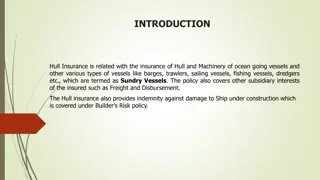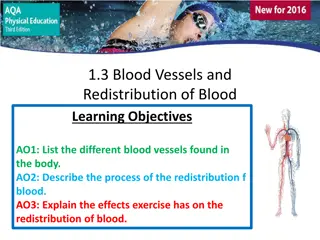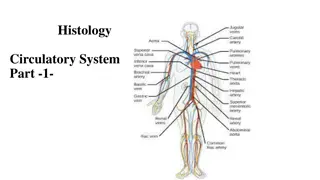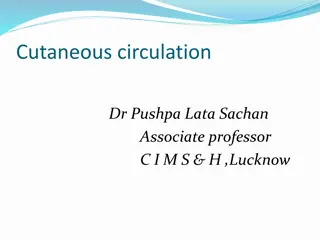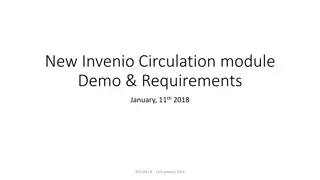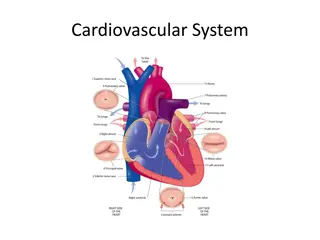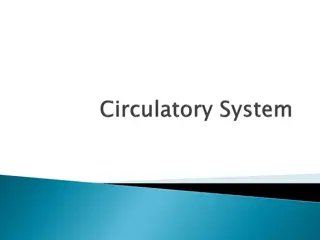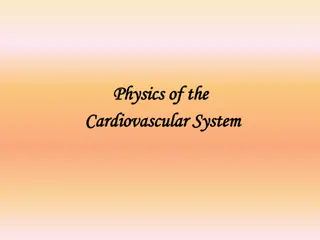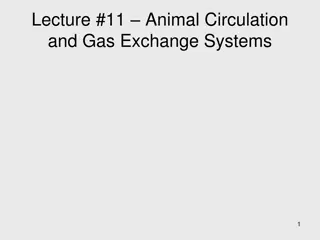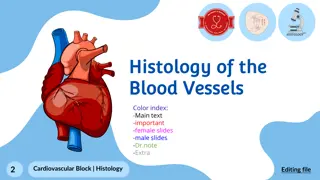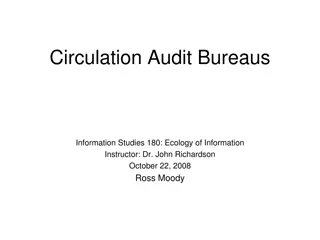Understanding Blood Vessels and Circulation
Explore the components of blood, features of red blood cells, and the journey of oxygen molecules in the circulatory system. Learn about the different types of blood vessels, their structures, functions, and how blood moves through veins. Engage in tasks and self-assessment to enhance your knowledge of the circulatory system.
Download Presentation

Please find below an Image/Link to download the presentation.
The content on the website is provided AS IS for your information and personal use only. It may not be sold, licensed, or shared on other websites without obtaining consent from the author. Download presentation by click this link. If you encounter any issues during the download, it is possible that the publisher has removed the file from their server.
E N D
Presentation Transcript
The Blood Vessels Do Now activity: 1. What are the four main components of blood? 2. Describe the features of a red blood cell which aids it s transportation of oxygen 3. Explain the journey an oxygen molecule takes from the alveoli to respiring tissues
Progress indicators GOOD PROGRESS: - Identify and label diagrams of the three main types of blood vessel - Describe the structure of each of the types of blood vessels OUTSTANDING PROGRESS: - Explain how the structure of each of the blood vessels relates to it s function in the circulatory system
Quick reminder Task: Match the blood component to it s role:
There are three main types of blood vessel in the human body: Artery Vein Capillary
Task: Answer the following questions on blood vessels whilst watching the video: 1. What does our blood flow through? 2. What are arteries and what do they do? 3. What structural feature do arteries have in order with stand high pressure? 4. What occurs at the capillaries? 5. What are endothelial cells? http://study.com/academy/lesson/blood-vessels-arteries-capillaries-more.html
Self-assessment: 1. Blood vessels arteries, veins, capillaries 2. Arteries are blood vessels which carry blood away from the heart to other tissues. 3. Arteries have thick elastic walls to withstand high blood pressure, these arteries expand when the pressure of the blood rises and then recoil when the heart relaxes between beats to provide a smooth flow of blood. 4. Capillaries are small, microscopic blood vessels where exchange of materials takes place between the blood and the body tissues 5. Endothelial cells are thin, flattened cells that line the inner wall of all blood vessels
How does blood move through the veins? Blood pushed forward towards the heart through open valves Backward flow of blood prevented by the closing of the valves as they fill with blood Backward prevented by valves closing Blood is passed through the veins by moving our limbs and breathing.
Vessel type artery vein capillary Diagram Direction of blood flow Blood pressure Blood colour Function Task: Memory game...how much can you get filled in with only 30 seconds to look at the information? Structure Valves?
vessel type artery vein capillary Diagram blood moving away from the heart blood moving towards the heart in organs and tissues, link between arteries and veins medium (20-30 mmHg) Direction of blood flow high (40-100 mmHg) low (5-20 mmHg) blood pressure oxygenated, bright red transport of oxygenated blood (except pulm. artery) deoxygenated, deep purply-red transport of deoxygenated blood (except pulm. Vein) both Blood colour exchange of O2, CO2, nutrients and waste between cells + blood Function structure thick muscular wall (elastic) small lumen (internal space) thin wall very thin wall (one layer of cells) very small lumen (red blood cells travel single file) no large lumen valves no yes
Double-circulation In humans and other mammals the blood vessels are arranged into a double-circulatory system. One transport system carries blood from your heart to your lungs and back again. The other transports blood from your heart to all other organs of your body and back again. a) The pulmonary circulation carries deoxygenated blood to the lungs to Q. What is the main job of the: exchange carbon dioxide for oxygen b) The systemic circulation carries the newly oxygenated blood from the heart to deliver oxygen to respiring tissues in the rest of the body a) Pulmonary circulation b)Systemic circulation
Plenary: Quick Check Task: Choose one of the following questions to answer: Describe one feature of a capillary, artery and a vein Explain how the feature relates to the function of the blood vessel Explain why veins do have valves whereas arteries do not






